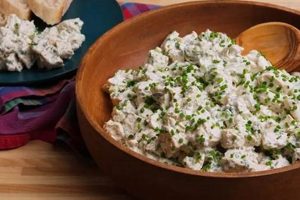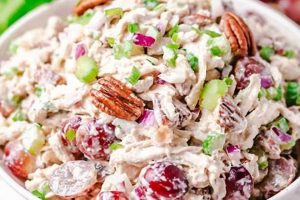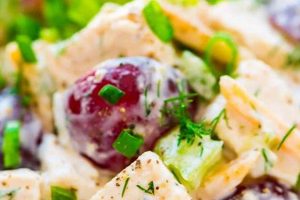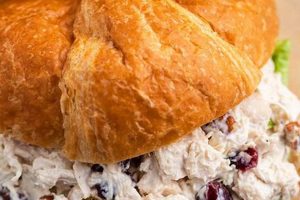A dish combining cooked chicken, mayonnaise-based dressing, and curry powder creates a flavorful, cold salad. Variations often incorporate fruits like grapes or apples, nuts such as almonds or cashews, and vegetables like celery or onion. A simple version might involve diced chicken, mayonnaise, curry powder, and salt, while more complex iterations can include chutney, yogurt, or fresh herbs.
This type of salad offers a versatile and convenient meal option. Its customizable nature allows for adjustments to suit individual dietary needs and preferences. From a light lunch to a picnic centerpiece or a potluck contribution, its adaptability shines. The historical blending of British and Indian culinary traditions provides a rich background, highlighting the global appeal of combining readily available ingredients into a satisfying dish.
Further exploration could delve into specific variations, nutritional information, tips for preparation and storage, or suggestions for complementary pairings.
Tips for a Superior Curry Chicken Salad
Optimizing flavor and texture requires attention to detail. These tips provide guidance for creating a truly exceptional salad.
Tip 1: Chicken Selection: Using pre-cooked rotisserie chicken offers convenience, but poaching or grilling chicken specifically for the salad enhances flavor control. Dark meat contributes richness, while white meat provides a leaner option.
Tip 2: Mayonnaise Base: Full-fat mayonnaise provides a creamy texture, but Greek yogurt or a combination offers a lighter alternative. Adjusting the mayonnaise-to-yogurt ratio allows customization of richness and tanginess.
Tip 3: Curry Powder Customization: Experimenting with different curry powder blends dramatically impacts the final flavor profile. Consider Madras curry powder for heat, or Korma for a milder, nuttier taste.
Tip 4: Balancing Sweet and Savory: Incorporating sweetness, such as chopped grapes, raisins, or diced apples, complements the savory curry notes. Balance the sweetness with a touch of acidity from lemon juice or apple cider vinegar.
Tip 5: Textural Variety: Toasted nuts, such as almonds or cashews, and chopped celery or red onion add satisfying crunch. Consider the size and texture of these additions for optimal enjoyment.
Tip 6: Chilling Time: Allowing the salad to chill for at least 30 minutes allows the flavors to meld. This enhances the overall taste experience.
Tip 7: Serving Suggestions: This versatile salad can be served on bread, crackers, lettuce cups, or as a filling for wraps or sandwiches.
By following these tips, one can elevate a simple chicken salad into a flavorful and nuanced culinary creation.
With these considerations in mind, the following section will delve into specific recipe variations.
1. Chicken (cooked, diced)
Cooked, diced chicken forms the foundational protein component of chicken curry salad. Its preparation method and inclusion significantly influence the final dish’s overall quality. Employing properly cooked chicken ensures food safety and contributes desirable textural attributes. Dicing the chicken into uniform pieces promotes even distribution throughout the salad, facilitating a balanced flavor experience in each bite. Overcooked chicken can result in a dry, stringy texture, detracting from the salad’s palatability. Conversely, undercooked chicken presents health risks. Appropriate cooking and dicing techniques yield tender, flavorful pieces that integrate seamlessly with the other ingredients.
Consider the impact of different cooking methods. Poached chicken offers a lean, moist base, while roasted chicken imparts richer flavors. The choice of cooking method allows customization based on desired flavor profiles and dietary considerations. For instance, a health-conscious individual might opt for poached chicken breast, while someone seeking a more robust flavor might choose roasted thigh meat. The size of the dice also impacts the final product. Smaller pieces create a smoother, more integrated texture, while larger pieces offer a more substantial bite. These seemingly minor details can significantly influence the overall culinary experience.
Ultimately, the success of a chicken curry salad hinges on the quality and preparation of the chicken. Thoughtful consideration of cooking methods and dicing techniques ensures optimal flavor, texture, and food safety. This foundational element establishes the framework for a satisfying and enjoyable dish.
2. Mayonnaise (base)
Mayonnaise serves as the crucial binding element in chicken curry salad, contributing texture, flavor, and overall cohesion. Its emulsification of oil and egg yolks creates a creamy consistency that coats the chicken and other ingredients, facilitating a harmonious blend of flavors. The richness of mayonnaise complements the savory curry spices, creating a balanced flavor profile. Without mayonnaise, the salad would lack the necessary moisture and cohesive texture, resulting in a dry, disjointed mixture. For example, a curry chicken salad lacking sufficient mayonnaise might crumble and lack the characteristic creamy mouthfeel. Conversely, excessive mayonnaise can render the salad overly rich and heavy. The quantity and quality of mayonnaise directly impact the final product’s success.
Beyond its textural contribution, mayonnaise also influences the perceived flavor profile. The tanginess of mayonnaise, derived from vinegar or lemon juice, provides a subtle counterpoint to the richness of the curry spices. This delicate balance prevents the salad from becoming overly savory. Furthermore, the fat content in mayonnaise carries flavor compounds, enhancing the perception of the curry spices and other ingredients. Different types of mayonnaise, such as those incorporating olive oil or flavored vinegars, can introduce subtle nuances to the overall flavor profile. Choosing a high-quality mayonnaise enhances the salad’s overall taste and texture. For instance, using a mayonnaise made with fresh lemon juice can brighten the flavor profile, while a mayonnaise incorporating Dijon mustard can add a subtle tangy complexity.
Understanding the multifaceted role of mayonnaise in chicken curry salad allows for informed recipe adjustments and optimal culinary outcomes. Balancing its quantity ensures the desired texture and cohesiveness while considering its flavor impact allows for nuanced flavor development. Successfully integrating mayonnaise as the base requires an appreciation of its textural and flavor contributions, ultimately leading to a well-balanced and satisfying dish.
3. Curry powder (flavor)
Curry powder stands as the defining characteristic of chicken curry salad, directly impacting its flavor profile. This blend of spices, originating from South Asian cuisine, introduces complex aromatic and flavor dimensions that distinguish the salad from other chicken salad variations. The specific composition of curry powder varies, but commonly includes turmeric, cumin, coriander, and chili peppers. This combination imparts earthy, warm, and subtly spicy notes, transforming the chicken and other ingredients into a cohesive, flavorful entity. Without curry powder, the dish would simply be chicken salad, lacking the distinctive character provided by this spice blend. For example, a Madras curry powder introduces a more intense heat, while a Korma curry powder offers milder, sweeter notes. The selection of curry powder directly influences the final flavor experience.
The interaction between curry powder and other ingredients within the salad creates a dynamic flavor landscape. The spices within the curry powder complement and enhance the flavors of the chicken, mayonnaise, and any included fruits or vegetables. For instance, the warmth of cumin might accentuate the sweetness of grapes, while the heat of chili peppers might contrast with the cooling effect of yogurt in the mayonnaise base. Understanding this interplay allows for strategic ingredient selection and precise flavor manipulation. The quantity of curry powder used also plays a significant role; too little might result in a bland salad, while too much can overwhelm the other flavors. Achieving a harmonious balance of flavors requires careful consideration of the curry powder’s intensity and its interaction with other components.
Curry powder’s essential role in defining chicken curry salad’s identity highlights its importance within the recipe. Its complex flavor profile transforms a simple combination of ingredients into a unique culinary experience. Careful selection and application of curry powder, considering its inherent characteristics and its interplay with other components, allows for tailored flavor profiles ranging from mild to intensely spicy, catering to a broad range of palates. Mastering this aspect of the recipe ensures a successful and satisfying culinary outcome, demonstrating a nuanced understanding of flavor dynamics.
4. Fruits/Vegetables (optional)
The incorporation of fruits and vegetables into a chicken curry salad recipe introduces textural and flavor complexities, elevating the dish beyond a simple protein-and-mayonnaise base. These additions contribute a refreshing counterpoint to the richness of the mayonnaise and the savory depth of the curry powder. The sweetness of fruits like grapes, raisins, or chopped apples balances the savory spices, while the crispness of vegetables such as celery, diced red onion, or shredded carrots provides textural contrast to the creamy base. Consider the interplay of flavors and textures: the tartness of dried cranberries against the warmth of curry, or the crunch of water chestnuts against the tender chicken. These seemingly minor additions create a more dynamic and engaging sensory experience. For instance, a curry chicken salad featuring crisp apples and toasted almonds offers a different textural and flavor profile than one with sweet grapes and slivered celery.
The strategic selection of fruits and vegetables offers opportunities to tailor the salad to specific flavor preferences and dietary needs. Incorporating ingredients with high water content, such as cucumber or bell peppers, can lighten the overall texture and add a refreshing element. Dried fruits, such as apricots or golden raisins, introduce concentrated sweetness and a chewy texture. The versatility of this element within the recipe allows for endless customization. One might incorporate chopped mango for a tropical twist, or roasted butternut squash for a seasonal autumnal variation. These additions not only enhance the flavor and texture but also contribute nutritional value, increasing the salad’s vitamin and fiber content. Understanding the specific contributions of each fruit and vegetable allows for informed choices that align with individual dietary goals and flavor preferences.
While optional, the inclusion of fruits and vegetables in a chicken curry salad recipe offers significant potential for enhancing both the sensory experience and nutritional value. Careful consideration of flavor pairings, textural interplay, and individual dietary needs allows for customized variations that elevate the dish beyond its basic components. This understanding allows one to create a chicken curry salad that is not only delicious but also tailored to specific preferences and nutritional goals, transforming a simple dish into a more complex and satisfying culinary creation.
5. Nuts/Seeds (optional)
Nuts and seeds, while optional, contribute significantly to the overall sensory experience of a chicken curry salad recipe. Their inclusion introduces textural complexity and nuanced flavor dimensions that complement the existing components. The primary contribution of nuts and seeds lies in their textural contrast. The inherent crunch of almonds, cashews, walnuts, sunflower seeds, or pumpkin seeds provides a counterpoint to the creamy mayonnaise base and the tender chicken, preventing a monotonous textural experience. This contrast elevates the enjoyment of the salad by engaging multiple sensory perceptions simultaneously. For example, the crispness of toasted slivered almonds contrasts sharply with the soft texture of poached chicken and the creamy mayonnaise, creating a more dynamic mouthfeel. Furthermore, different nuts and seeds offer varying levels of crunch, from the delicate crispness of pine nuts to the more substantial crunch of roasted cashews, allowing for customized textural experiences.
Beyond texture, nuts and seeds also contribute subtle flavor enhancements. The inherent nuttiness of almonds, walnuts, or pecans complements the warm spices within the curry powder, adding depth and complexity to the overall flavor profile. Seeds, such as sunflower or pumpkin seeds, offer subtly earthy notes that further enhance the flavor landscape. Furthermore, toasting nuts and seeds before incorporating them into the salad amplifies their inherent flavors and aromas, intensifying their impact on the overall sensory experience. For example, toasting slivered almonds before adding them to the salad enhances their nutty flavor and creates a more pronounced textural contrast. Additionally, the choice of nuts and seeds can introduce subtle flavor variations. The buttery flavor of macadamia nuts provides a different nuance than the slightly bitter note of toasted walnuts.
In conclusion, the inclusion of nuts and seeds in a chicken curry salad recipe, while optional, presents a valuable opportunity to elevate the dish through textural and flavor enhancements. Their contrasting crunch provides a more engaging mouthfeel, while their inherent flavors complement the existing components, creating a more complex and satisfying sensory experience. Understanding the contributions of various nuts and seeds allows for informed choices based on desired textural and flavor profiles, demonstrating a nuanced approach to recipe development and culinary creativity. The strategic use of these optional ingredients transforms a basic chicken curry salad into a more sophisticated and enjoyable culinary creation.
Frequently Asked Questions
This section addresses common inquiries regarding chicken curry salad recipes.
Question 1: What type of chicken is best suited for curry chicken salad?
While pre-cooked rotisserie chicken offers convenience, using freshly cooked chicken allows for greater control over flavor and texture. Both white and dark meat can be utilized, depending on individual preferences for leanness versus richness.
Question 2: Can the mayonnaise be substituted for a lighter alternative?
Greek yogurt or a combination of mayonnaise and Greek yogurt offers a lighter, tangier alternative to full-fat mayonnaise. Adjusting the ratio allows for customization of richness and calorie content.
Question 3: How can the level of spiciness be adjusted?
The type and quantity of curry powder used directly impacts the level of spiciness. Milder curry powders, such as Korma, create a less spicy salad, while hotter varieties, such as Madras, increase the heat. Adjusting the amount of curry powder allows for fine-tuning the spice level.
Question 4: How long can chicken curry salad be stored?
Properly stored in an airtight container in the refrigerator, chicken curry salad typically lasts for three to five days. Ensuring the chicken is thoroughly cooked and the salad is chilled promptly contributes to safe storage.
Question 5: What are suitable accompaniments for chicken curry salad?
Chicken curry salad pairs well with various accompaniments, including bread, crackers, lettuce cups, croissants, or as a filling for sandwiches and wraps. Consider the flavor profile of the salad when selecting accompaniments; for example, a sweeter curry salad might pair well with croissants, while a spicier version might be better suited for a crisp lettuce wrap.
Question 6: Can frozen chicken be used in this recipe?
While frozen chicken can be used, it is essential to thaw it completely and cook it thoroughly before incorporating it into the salad. Ensure the chicken reaches a safe internal temperature to mitigate food safety risks.
Addressing these frequently asked questions provides a comprehensive understanding of essential aspects of chicken curry salad preparation and storage. These insights equip individuals with the knowledge to create and enjoy this versatile dish safely and effectively.
The following section will explore variations on the classic chicken curry salad recipe.
Chicken Curry Salad Recipe
Exploration of this culinary concept reveals a dish offering versatility and adaptability. From the foundational elements of cooked chicken, mayonnaise, and curry powder to the nuanced additions of fruits, vegetables, and nuts, the recipe allows for extensive customization based on individual preferences and dietary considerations. Understanding the interplay of these components, including the impact of various curry powders and the textural contributions of optional ingredients, empowers culinary creativity. Proper preparation and storage techniques ensure both safety and optimal enjoyment of this versatile dish.
The adaptability of chicken curry salad positions it as a dish with enduring appeal. Its capacity for customization ensures relevance across diverse culinary landscapes and evolving dietary trends. Further exploration of regional variations and innovative ingredient combinations promises continued evolution and enjoyment of this classic dish.






